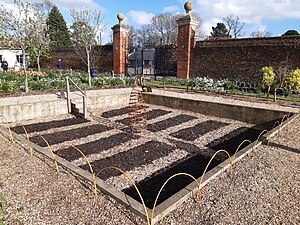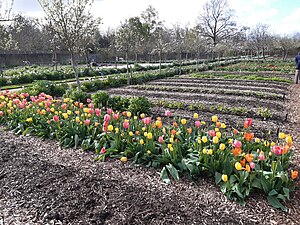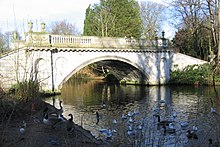
Richard Boyle, 3rd Earl of Burlington and 4th Earl of Cork, was a British architect and noble often called the "Apollo of the Arts" and the "Architect Earl". The son of the 2nd Earl of Burlington and 3rd Earl of Cork, Burlington never took more than a passing interest in politics despite his position as a Privy Counsellor and a member of both the British House of Lords and the Irish House of Lords. His great interests in life were architecture and landscaping, and he is remembered for being a builder and a patron of architects, craftsmen and landscapers, Indeed, he is credited with bringing Palladian architecture to Britain and Ireland. His major projects include Burlington House, Westminster School, Chiswick House and Northwick Park.

William Kent was an English architect, landscape architect, painter and furniture designer of the early 18th century. He began his career as a painter, and became Principal Painter in Ordinary or court painter, but his real talent was for design in various media.

Chiswick House is a Neo-Palladian style villa in the Chiswick district of London, England. A "glorious" example of Neo-Palladian architecture in west London, the house was designed and built by Richard Boyle, 3rd Earl of Burlington (1694–1753), and completed in 1729. The house and garden occupy 26.33 hectares. The garden was created mainly by the architect and landscape designer William Kent, and it is one of the earliest examples of the English landscape garden.
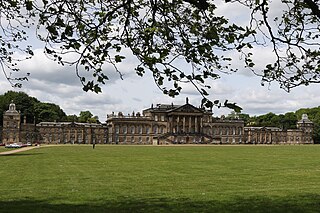
Wentworth Woodhouse is a Grade I listed country house in the village of Wentworth, in the Metropolitan Borough of Rotherham in South Yorkshire, England. It is currently owned by the Wentworth Woodhouse Preservation Trust. The building has more than 300 rooms, with 250,000 square feet (23,000 m2) of floorspace, including 124,600 square feet (11,580 m2) of living area. It covers an area of more than 2.5 acres (1.0 ha), and is surrounded by a 180-acre (73 ha) park, and an estate of 15,000 acres (6,100 ha).

The Villa d'Este is a 16th-century villa in Tivoli, near Rome, famous for its terraced hillside Italian Renaissance garden and especially for its profusion of fountains. It is now an Italian state museum, and is listed as a UNESCO World Heritage Site.

Palladian architecture is a European architectural style derived from the work of the Venetian architect Andrea Palladio (1508–1580). What is today recognised as Palladian architecture evolved from his concepts of symmetry, perspective and the principles of formal classical architecture from ancient Greek and Roman traditions. In the 17th and 18th centuries, Palladio's interpretation of this classical architecture developed into the style known as Palladianism.

Charles Bridgeman (1690–1738) was an English garden designer who helped pioneer the naturalistic landscape style. Although he was a key figure in the transition of English garden design from the Anglo-Dutch formality of patterned parterres and avenues to a freer style that incorporated formal, structural and wilderness elements, Bridgeman's innovations in English landscape architecture have been somewhat eclipsed by the work of his more famous successors, William Kent and Lancelot "Capability" Brown.
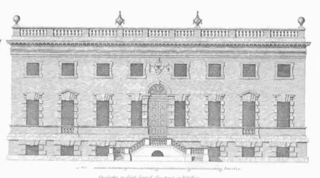
Colen Campbell was a pioneering Scottish architect and architectural writer who played an important part in the development of the Georgian style. For most of his career, he resided in Italy and England. As well as his architectural designs, he is known for Vitruvius Britannicus, three volumes of high-quality engravings showing the great houses of the time.

Prior Park Landscape Garden surrounding the Prior Park estate south of Bath, Somerset, England, was designed in the 18th century by the poet Alexander Pope and the landscape gardener Capability Brown, and is now owned by the National Trust. The garden was influential in defining the style known as the "English landscape garden" in continental Europe. The garden is Grade I listed in the Register of Historic Parks and Gardens of special historic interest in England.

Hadrian's Villa is a UNESCO World Heritage Site comprising the ruins and archaeological remains of a large villa complex built around AD 120 by Roman emperor Hadrian near Tivoli outside Rome.

The English landscape garden, also called English landscape park or simply the English garden, is a style of "landscape" garden which emerged in England in the early 18th century, and spread across Europe, replacing the more formal, symmetrical French formal garden which had emerged in the 17th century as the principal gardening style of Europe. The English garden presented an idealized view of nature. Created and pioneered by William Kent and others, the "informal" garden style originated as a revolt against the architectural garden and drew inspiration from landscape paintings by Salvator Rosa, Claude Lorrain, and Nicolas Poussin.

The Villa Doria Pamphili is a seventeenth-century villa with what is today the largest landscaped public park in Rome, Italy. It is located in the quarter of Monteverde, on the Gianicolo, just outside the Porta San Pancrazio in the ancient walls of Rome where the ancient road of the Via Aurelia commences.

Holkham Hall is an 18th-century country house near the village of Holkham, Norfolk, England, constructed in the Neo-Palladian style for the 1st Earl of Leicester by the architect William Kent, aided by Lord Burlington.

The art collection of Holkham Hall in Norfolk, England, remains very largely that which the original owner intended the house to display; the house was designed around the art collection acquired by Thomas Coke, 1st Earl of Leicester, during his Grand Tour of Italy during 1712–18. To complete the scheme it was necessary to send Matthew Brettingham the younger to Rome between 1747 and 1754 to purchase further works of art.

Italian garden typically refers to a style of gardens, wherever located, reflecting a number of large Italian Renaissance gardens which have survived in something like their original form. In the history of gardening, during the Renaissance, Italy had the most advanced and admired gardens in Europe, which greatly influenced other countries, especially the French formal garden and Dutch gardens and, mostly through these, gardens in Britain.

The Diana Fountain in Bushy Park, in the London Borough of Richmond upon Thames, England, is a seventeenth-century statue ensemble and water feature in an eighteenth-century setting with a surrounding pool and mile long tree lined vistas which honors the Roman Goddess Diana. Originally created for Somerset House in the 1630s, and remodelled about 1690, the fountain has stood since 1713 in Bushy Park, and now forms a large traffic island in Chestnut Avenue.

Chiswick House is an example of English Palladian Architecture in Burlington Lane, Chiswick, in the London Borough of Hounslow in England. Arguably the finest remaining example of Neo-Palladian architecture in London, the house was designed by Lord Burlington, and built between 1727 and 1729. The architectural historian Richard Hewlings has established that Chiswick House was an attempt by Lord Burlington to create a Roman villa, rather than Renaissance pastiche, situated in a symbolic Roman garden. Chiswick House is inspired in part by several buildings of the 16th-century Italian architects Andrea Palladio (1508–1580) and his assistant Vincenzo Scamozzi (1552–1616). The house is often said to be directly inspired by Palladio's Villa Capra "La Rotonda" near Vicenza, due to the fact that architect Colen Campbell had offered Lord Burlington a design for a villa very closely based on the Villa Capra for his use at Chiswick. However, although still clearly influential, Lord Burlington had rejected this design and it was subsequently used at Mereworth Castle, Kent. Lord Burlington was not just restricted to the influence of Andrea Palladio as his library list at Chiswick indicates. He owned books by influential Italian Renaissance architects such as Sebastiano Serlio and Leon Battista Alberti and his library contained books by French architects, sculptors, illustrators and architectural theorists such as Jean Cotelle, Philibert de l'Orme, Abraham Bosse, Jean Bullant, Salomon de Caus, Roland Fréart de Chambray, Hugues Sambin, Antoine Desgodetz, and John James's translation of Claude Perrault's Treatise of the Five Orders. Whether Palladio's work inspired Chiswick or not, the Renaissance architect exerted an important influence on Lord Burlington through his plans and reconstructions of lost Roman buildings; many of these unpublished and little known, were purchased by Burlington on his second Grand Tour and housed in cabinets and tables the Blue Velvet Room, which served as his study. These reconstructions were the source for many of the varied geometric shapes within Burlington's Villa, including the use of the octagon, circle and rectangle. Possibly the most influential building reconstructed by Palladio and used at Chiswick was the monumental Roman Baths of Diocletian: references to this building can be found in the Domed Hall, Gallery, Library and Link rooms.

Pieter Andreas Rijsbrack was a Flemish painter of still lifes and landscapes who was active in England in the first half of the 18th century. He is particularly known for launching the vogue of topographical views of English country houses and gardens. He was the older brother of the sculptor John Michael Rysbrack.

Stowe Gardens, formerly Stowe Landscape Gardens, are extensive, Grade I listed gardens and parkland in Buckinghamshire, England. Largely created in the 18th century, the gardens at Stowe are arguably the most significant example of the English landscape garden. Designed by Charles Bridgeman, William Kent, and Capability Brown, the gardens changed from a baroque park to a natural landscape garden, commissioned by the estate's owners, in particular by Richard Temple, 1st Viscount Cobham, his nephew Richard Grenville-Temple, 2nd Earl Temple, and his nephew George Nugent-Temple-Grenville, 1st Marquess of Buckingham.










